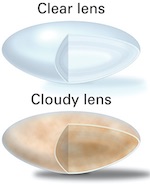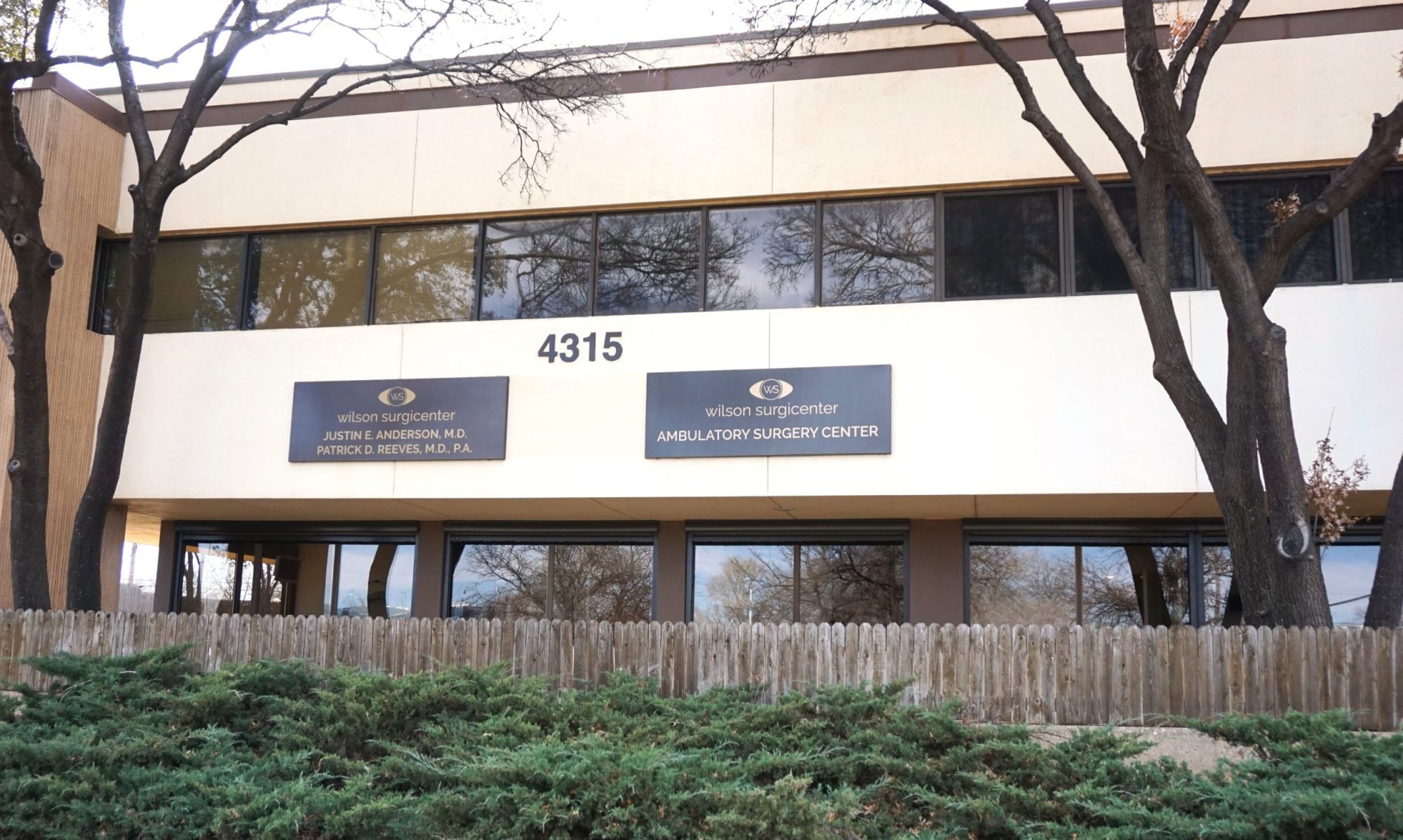
Inside everyone’s eye there is a lens, just like a lens inside a camera. With time and age that lens becomes cloudy. We call that cloudy lens a cataract, and it is treated with cataract surgery. During the surgery, the cloudy lens is removed, and a clear plastic lens is put in its place. Since the new lens is clear (instead of cloudy), it helps you see more clearly.
There are a variety of lens implant options. At your first visit you and your surgeon will discuss which lens implant options might be right for you.
NOTE: Not all patients are candidates for all lens implant options available with cataract surgery due to other diseases that may be present (e.g. macular degeneration, dry eye, diabetes or other eye issues).
Standard Lens Implant

The standard lens implant is covered by all insurance companies and helps many people see better. Our office and surgery center accept many private insurances as well as Medicare and Medicaid. The standard lens implant does not correct astigmatism nor does it help with nearer vision tasks (like seeing your phone).
Despite these limitations, many patients can achieve great distance vision using the standard lens implant. About half of patients can achieve good distance vision without glasses using the standard lens implant. The other half will require correction (glasses or contacts) for the clearest distance vision possible. You should expect to use reading glasses or bifocals for near vision (arms length in) with this lens implant.
Standard Lens Implant Summary
- Advantages – can help many people achieve good vision at no additional cost
- Disadvantages – does not correct astigmatism or help with near vision
- Recommendation – a good choice for patients with little to no astigmatism and those who don’t mind wearing glasses and/or want to avoid additional expense
Premium Lens Implant Options
Premium lens implants have special features built into them to correct your vision in ways not provided by the standard lens implant. These lenses can help correct astigmatism, help improve vision for nearer tasks (like reading your phone), or both.
Premium Lens Implant – Astigmatism Correcting Lens Implant
What is Astigmatism? When the front part of the eye is shaped like a perfect sphere (like a soccer ball) there is no astigmatism. However, when the front part of the eye is shaped more like an egg or a football, the eye is said to have astigmatism. Astigmatism cause blurring of both near and distance vision and is typically corrected with glasses or contacts.

At the time of your cataract surgery, we can take some of the astigmatism correcting power from your glasses and put it inside the lens implant with an astigmatism correcting lens implant. This lens should help patients with astigmatism achieve better distance vision without glasses or contacts. For nearer vision tasks, patients will still wear reading glasses or bifocals.
There are two disadvantages to the astigmatism correcting lens implant. First, insurance does not cover the cost of the cost of this lens implant. Thus this lens implant is only available at an additional fee. The second disadvantage is that there is an increased risk of requiring a second surgery. Why? The lens implant must remained perfectly aligned through surgery and the healing period of the eye. If the lens implant becomes misaligned, then it may require a second operation to reposition the lens. The literature indicates that up to two percent of patients may require a second operation to reposition the lens.
Astigmatism Lens Implant Summary
- Advantages – can correct astigmatism for better distance vision without glasses
- Disadvantages – additional cost, increased chance of repositioning, does not help with nearer vision tasks
- Recommendation – this lens is a good choice for patients with astigmatism who desire to be less dependent on glasses for distance vision activities
Premium Lens Implant – Symfony EDOF Lens Implant

The Symfony EDOF lens implant is a type of “presbyopia correcting lens implant.” Presbyopia is when you lose the ability to focus on nearer objects (from arms length in) without glasses. It usually starts around age 40-45 and is corrected with reading glasses or bifocals.
At the time of your cataract surgery, we can take some of the near vision power from your bifocals/reading glasses and put it inside the lens implant with the Symfony EDOF lens implant. This lens should help patients achieve good distance vision and good vision for nearer tasks like reading your phone at about arms length. For very fine print and very close up work, a light pair of reading glasses may still be necessary.
There are two disadvantages to the Symfony EDOF lens implant. First, insurance does not cover the cost of the cost of this lens implant. Thus this lens implant is only available at an additional fee. The second disadvantage is that presbyopia-correcting lens implants can cause glare or halos around lights at night. This is noticeable with oncoming headlights or street lights. The effect is often described as a spiderweb appearance around lights at night.
Symfony Lens Implant Summary
- Advantages – can help with good distance and nearer/arms length vision without glasses
- Disadvantages – additional cost, halos/spiderwebs around lights at night, light readers may still needed at times
- Recommendation – this lens is a good choice for patients who desire to be less dependent on glasses for distance and nearer vision activities (arms length)
NOTE: The Symfony EDOF lens implant to correct astigmatism is also available.
Other Premium Lens Implant Options
There are a variety of other premium lens implant options. However, most other options have over-promised and under-performed over the last 20 years. Some lenses only help with nearer vision for the first couple of years, then the effect wears off. Other lenses might provide near and distance vision, but that vision is not practically usable – missing all the mid-range vision used for grocery shopping and seeing your car dashboard. Others cause patient dissatisfaction because of glare/halos and/or poor quality of vision.
Therefore, based on 35 years of combined cataract surgery experience, our doctors currently recommend the lens implant options listed above.
Monovision
Monovision is another option that some people use to correct for presbyopia. Usually patients in their 40’s will begin wearing one contact lens that gives them good near vision and another contact lens that gives them good distance vision. Thus they have have one “near eye” and one “distance eye” while wearing their contact lenses.
If you have been wearing monovision contact lenses for years and are very happy with it, then our surgeons can select the lens implant power that mimics your contact lenses. Thus you can have the advantage of one eye set for near and the other eye set for distance without the inconvenience of having put your contact lenses in and out every day.
In our experience, only patients who have worn monovision contacts for years (and been happy with it) are good candidates for monovision cataract surgery. Why? Only about half the people who try monovision contacts can tolerate it. That’s no big deal if you are trying a pair of monovision contact lenses. You simply take them out and throw them away. However, if your eyes are set to monovision with cataract surgery and you don’t like it, that is a big deal. It would require a second surgery to reverse the monovision. Thus, cataract surgery is NOT the time to experiment with monovision.
Monovision Summary
- Advantages – can help with good distance and near vision without glasses
- Disadvantages – there is some loss of depth perception, you are asking one eye to do the work usually done by two eyes
- Recommendation – this is a good choice for patients who have worn monovision contacts for years and desire to be less dependent on glasses for distance and near vision activities without the inconvenience of contacts
Choosing the Lens Implant Option that is Right for You
So which lens implant option is right for you? This is something that depends on your vision goals and the condition of your eyes. Based on your eye exam at Wilson Surgicenter, your doctor will make a recommendation that, in his opinion, is best suited to your individual circumstances. The two of you will then discuss and agree on a surgical plan together.
Helpful Questions
One way to help guide your thought process (and to help our surgeons) is to ask yourself several questions below:
- Do I want to be less dependent on glasses or do I like my glasses?
- Am I most willing to wear glasses for near vision, distance vision, or at all times?
- Do I have a history of vision corrections surgery (LASIK/PRK/RK)?
- Do I have a history of monovision?
- Am I willing to pay additional expenses out of pocket or only what insurance covers?
- Am I willing to tolerate halos/spiderwebs around lights at night for better nearer vision?
Vision Simulator
Another way to help guide your though process is to use an online “vision simulator.” You can access it at your convenience, and it shows what your vision would theoretically be like depending on what type of lens implant you might choose.
Click “Understanding Your IOL Options” in blue. Be sure to select “Click to See the IOL Light Distribution” at the bottom of the page as well.
Also check out the “Vision Simulator” in red. If you have astigmatism, click the “I have astigmatism” box at the top of the page. If not, leave the box unchecked. Then scroll through the options at the top and bottom of the page. This will simulate what type of vision you might have depending on if you have astigmatism, the lens implant type you choose, and various lighting situations.
Find the TECNIS Vision Simulator at this link.
At Wilson Surgicenter we look forward to helping you select the lens implant option that best fits your needs, your lifestyle, and your individual circumstances.

